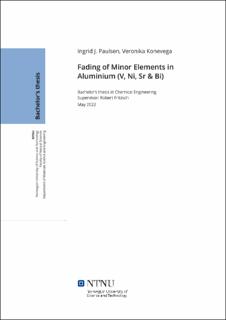| dc.contributor.advisor | Fritzsch, Robert | |
| dc.contributor.author | Paulsen, Ingrid Johanne | |
| dc.contributor.author | Konevega, Veronika | |
| dc.date.accessioned | 2022-07-06T17:20:32Z | |
| dc.date.available | 2022-07-06T17:20:32Z | |
| dc.date.issued | 2022 | |
| dc.identifier | no.ntnu:inspera:113593029:113594750 | |
| dc.identifier.uri | https://hdl.handle.net/11250/3003259 | |
| dc.description.abstract | Resirkuleringen av aluminium (Al), kalt sekundær Al, har blitt en stor del av den totale omsetningen av produsert Al. Veksten i bruk av sekundær Al i industrien er drevet av det lave energiforbruket, hvor det kun kreves ca. 5% av den totale energien ved produksjon av primær Al. Veksten i produksjon av sekundær Al har ført til oppdagelsen av nye utfordringer, som akkumulering eller fading av elementer i det resirkulerte metallet, som over tid kan akkumulere til mengder som påvirker kvaliteten, sammensetningen og egenskapene til sluttproduktet.
Denne studien har fokusert på fire elementer: V, Ni, Sr og Bi, og deres interaksjoner med smeltet aluminium med kommersiell renhet (99,7%), og dens legering, her testet med AlSi7. Interaksjonene mellom elementene, som er tilsatt en konsentrasjon på ca. 200 ppm, og det smeltede Al ble analysert over intervaller på 1 time, 2 timer og 20 timer. Elementene ble tilsatt det smeltede aluminiumet i flytende tilstand, temperaturen ble kontinuerlig holdt på 730°C ± 5°C, med omgivelig trykk og atmosfære i Boron Nitride (BN) belagte digler. Prøver ble tatt etter bestemt røring, med et gitt intervall, ved å helle smelten ut av digelen, samt ved å unngå kontaminering i smelten.
Prøvene ble deretter analysert ved GD-OES og GD-MS, mens noen prøver ble sendt til Hösch Metallurgy, Tyskland, for analyseres ved ICP-OES.
FactSage ble brukt til å generere de nødvendige binære fasediagrammene. Fasediagrammene ble brukt til å teoretisk bestemme mulige interaksjoner mellom elementene og Al.
Resultatene antyder at V, Ni og Bi er stabile i både ren Al og AlSi7-legering, for en tidsperiode på 20 timer, og viser ingen tegn til fading. Sr derimot, er det eneste elementet i denne studien som fader ut av aluminiumet, hvor elementet etter 6 timer viser antydninger til å ha fadet til konsentrasjoner på < 1 ppm.
Videre arbeid bør inkludere flere viktige legeringselementer. Eksperimentelle forsøk i industriell skala kan også vurderes. | |
| dc.description.abstract | The recycling of aluminium (Al), called secondary Al, has become a major part of the total value of all Al produced. The growth of secondary Al usage in many different industries is driven by the low energy consumption, requiring only approx. 5% of the total energy in comparison to the production of the primary Al. The growth of secondary Al production has led to the discovery of new challenges, such as accumulation or fading of elements in the recycled metal, which can, over time accumulate to such amounts that affect the quality, composition and properties of the end-product.
This study has focused on four elements: V, Ni, Sr and Bi, and their interactions with molten Al of commercially purity (99,7%), and its alloy, here tested with AlSi7. The interactions between the elements, which have been added with a concentration of approx. 200 ppm, and molten Al were analysed over intervals of 1h, 2h and 20h. The elements were added to the molten aluminium in liquid state, the temperature was continuously kept at 730°C ± 5°C, ambient pressure and atmosphere in Boron Nitride (BN) coated crucibles. Samples were taken after dedicated stirring actions, at a decided interval by pouring melt out of the crucible, avoiding contaminating the melt.
The samples were then analysed using GD-OES and GD-MS, while some samples were sent to Hösch Metallurgy, Germany, to be analysed using ICP-OES.
FactSage was used to generate the required binary phase diagrams. The phase diagrams were used to theoretically determine possible interactions between the elements and Al.
The results suggest that V, Ni and Bi are stable in both the pure Al and the AlSi7-alloy for a 20 hour time period, showing no sign of fading. Sr in contrast, is the only element in this study that fades out of the melt, where it appears to fade to concentrations of < 1 ppm after 6 hours.
Further work should include the study of further major alloying elements. Experimental trials at an industrial scale may also be considered. | |
| dc.language | eng | |
| dc.publisher | NTNU | |
| dc.title | Fading of Minor Elements in Aluminium (V, Ni, Sr & Bi) | |
| dc.type | Bachelor thesis | |
